A chat by Zoom interrupted by the deficient internet connection. Long minutes happen. Claudia Luna is talking about her career and her ideas. She is a mexican artist who loves public spaces and geometry, sculpture and painting, etc. Recently she published a book about collaborative sculpture. The chat starts and we talk about one of her drawings.
Una conversación por Zoom interrumpida por la mala conexión a internet. Suceden unos minutos. Claudia Luna nos cuenta sobre su trayectoria y sus ideas. Claudia es artista, escultora, pintora, le interesa el espacio público y la geometría, entre otras cosas. Hace poco publicó su libro de escultura compartida. Recién comienza la charla conversamos sobre uno de sus dibujos.
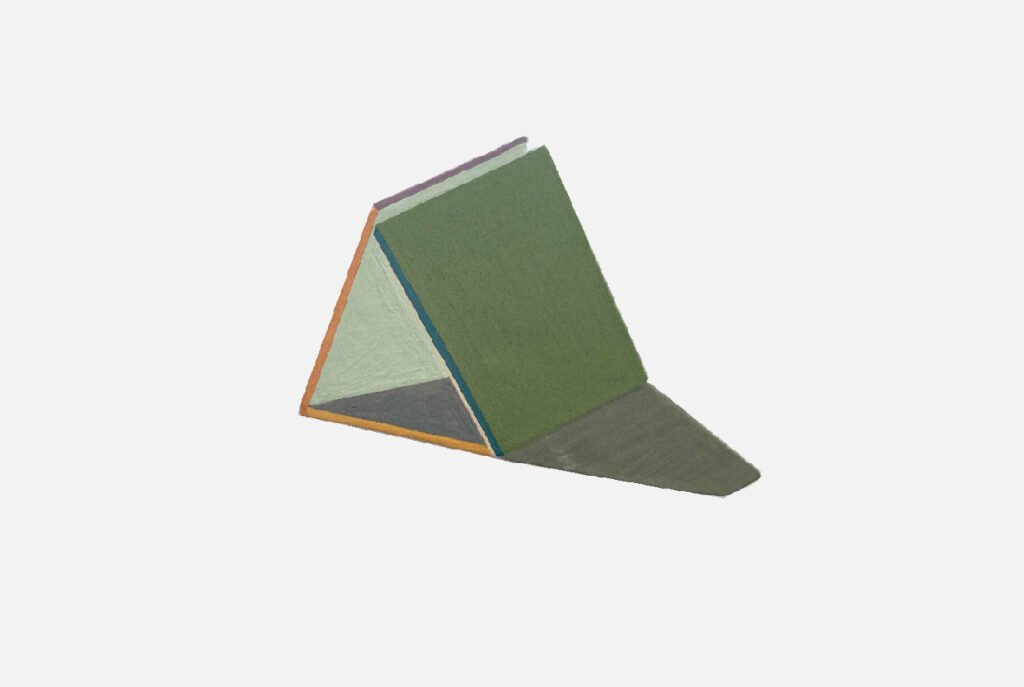
Gerardo: Cuéntame más o menos de tu trayectoria o que estudiaste, que no estudias, un poquito de tus inicios.
Claudia: Pues yo estudié en la FAD, bueno, antes se llamaba ENAP. Como que nunca pensé que quería ser artista, más bien pasó como medio al final del CCH por una materia que tomé optativa y que era como de dibujo técnico y cosas así. Y como que mi profe era muy comprometido… Nos dejó un montón de técnicas: acrílico, pastel, óleo y cosas así. Y entonces en el último semestre del CCH lo decidí. O sea, según yo iba para ciencias o algo así, pero tomé esa clase y pues ya como que me voló la cabeza, así me enteré que existía una carrera de artes en la UNAM. Y pues tenía el pase directo. Ya después me enteré que había otras escuelas, como la Esmeralda.
Gerardo: Por lo que tengo entendido allí enseñan varias cosas, ¿no? Aparte, cosas cual grabado, serigrafía, entre otras, y que trabajan en el taller. O sea, cómo que es más… Es un poco más rudo, siento.
Claudia: Sí, es bastante manual. O sea, siento que eso también me curtió porque cómo que aprendes a resolver cosas con tus medios y con las manos. Entonces como que sí es una licenciatura muy manual, muy de oficio y pues sí, tiene cosas buenas y cosas malas. Cómo todo. En ese momento pues yo como que no sabía qué hacer y tomé varios talleres: pintura, foto, grabado, ¿qué más?… Lo que nunca tomé fue escultura. Lo cual se me hace chistoso ahorita, porque es básicamente lo que estoy haciendo ahora. Tampoco nunca tomé taller de cerámica, y en este momento estoy súper clavada en la cerámica. Entonces estuvo chido, pero también fue una etapa de mucha desilusión.
Gerardo: Escuchándote, siento que tenías otros intereses entonces.
Claudia: Sí, como que en ese momento creí que me interesaba más la bidimensión, pero ya ahorita creo que ya no tanto.
Gerardo: Could you tell me about your career as an artist? Maybe about beginnings.
Claudia: Well, I studied at FAD. It was ENAP before. I never thought I would become an artist, I think it just happened in the final part of my high school time when I studied something like drawing. And my teacher was so passionate and committed… He taught us so many techniques like oil, pastel, acrylic, etc. So, at that moment I realized I can do it. I mean, I wanted to study something like science or whatever, but I was on that course and my mind just blew out, so I read that UNAM also offers art careers. I got a pass. So, after that I heard other schools also got it, like Esmeralda.
Gerardo: I heard that UNAM teaches so many things, you know? Most of all like etching, serigraphy, etc, I mean it’s more like being in workshops. I feel it is more of a duty.
Claudia: Yes, of course. It’s more like handcraft work. I mean, I feel it was also important for me because I learnt how to resolve it with my hands. So, yeah, it has good things but bad too. Like everything. At that moment I did not know what to do and I assisted in workshops where I learnt painting, photography, etching, etc. I didn’t learn sculpture. And I didn’t take a course on ceramic as well, but now I’m keen on it. It was cool, but it was also time for disappointment.
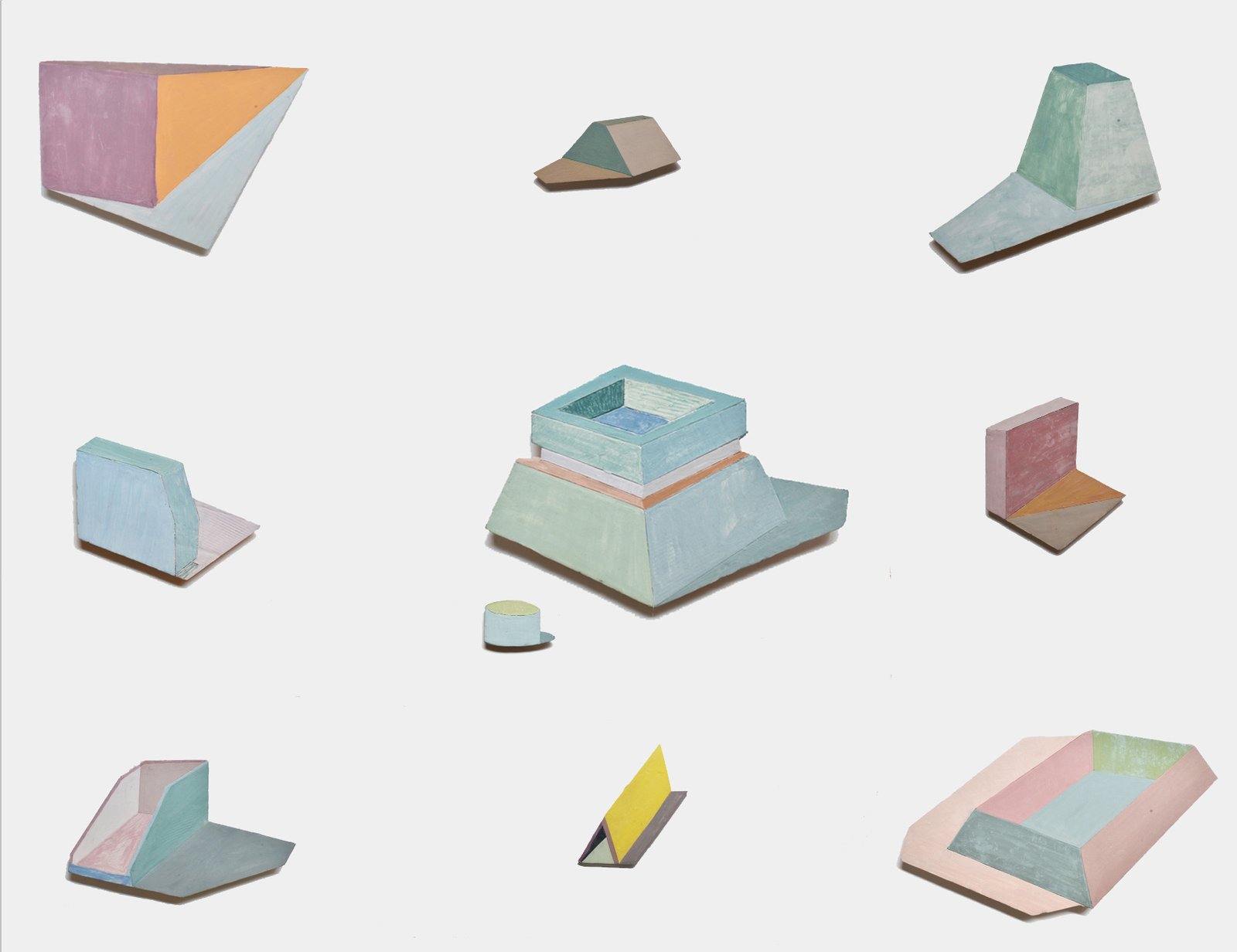
G: Ya, ya. Es curioso, ¿no? Ese cambio. Me hace pensar, por ejemplo: ¿en qué momento te das cuenta que puedes ser artista? Porque creo que una cosa es estudiar ahí adentro y aprender muchas técnicas y luego un momento cómo que te cae el 20 y dices: «creo que ya está».
C: Está bien difícil ese momento. Creo que, pues sí, no es broma cuando me decían que era como una carrera de resistencia. La verdad sí. Desde que salí de la escuela siempre he tenido un trabajo alterno al de ser artista, como para poder sostener mis gastos y la producción de obra. Entonces, está chistoso. Cómo que siempre sentí que era como artista de medio tiempo. Y sí, eso me gusta. De hecho, todavía ahorita es así. Cuando realmente sentí que ya me la estaba creyendo un poquito fue cuando terminé la licenciatura y me quedé como dos años más en la escuela; o sea, ya sin créditos ni nada, estaba como en un grupo de artistas multidisciplinarios. Nos veíamos los jueves para platicar de lecturas y de cosas que nos interesaban. Y luego de eso, me empecé a meter en concursos, talleres, aplicar a becas y vi que empezó a pegar, y eso me ayudó a seguir motivándome.
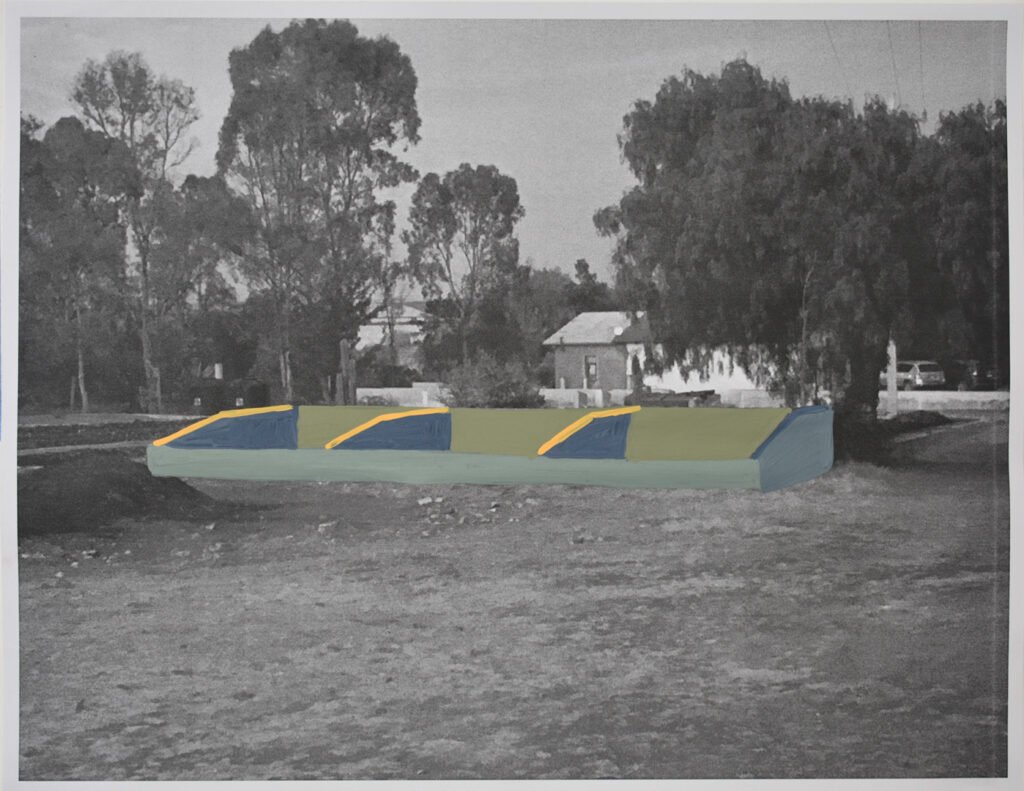
G: Si, te alienta, ¿no?
C: Si. Si. Entonces como que empezaron las exposiciones, ponerse de acuerdo con tus compas para mostrar el trabajo, no sé, como que fueron… Son pequeños pasitos que se van juntando y ya después cuando te das cuenta ya llevas haciéndolo por 10 años, y por tanto ya como que dices: «ah, creo que sí». Lo digo porque yo salí en 2011 de la escuela.
G: Ya tiene un rato.
C: Sí, ya tiene un ratito. Ja. Pero, sí, pues a la par de eso me ha tocado hacer muchas otras cosas para poder sostenerlo, trabajaba en una heladería, fui maestra por cinco años, después me metí de asistente de diversos artistas. ¿Qué más? Pues siempre me vi dando clases, y a veces de materias que no eran artes visuales. Estuve un rato grande trabajando en una escuela de animación se llama SAE. Le agarré un poco en la onda y luego di clases hasta en un Unitec. No sé. Luego después tienes que armar tu portafolio y ya te empiezas a dar cuenta de que hay página, y página, y página, y dices: «ah, vale». Creo que también ayudó un poco el nunca dejar de estudiar. Creo que eso sí me ayudó, porque siempre andaba buscando talleres o cursos, diplomados, entonces he pasado, por ejemplo: en el Centro de la Imagen tienen un programa que se llama SPF, siento que me ayudó muchísimo.
G: ¿Este programa qué es?
C: Es un programa que se llama Seminario de Producción Fotográfica, ¡me tocó con una artista que admiro mucho: Verónica Gerber Bicecci! Y sentí que ella le dio un giro bien padre, porque era pensar sobre la imagen. Entonces eso abrió un campo de posibilidades que no se arraiga en una técnica, no necesariamente fotografía o en mi caso pintura, la imagen en general. Para el término de este programa presenté una animación.
G: While I’m listening to you I feel you wanted to be something else.
C: Yeah, of course. I think at that moment I am interested in bi-dimension, but no more.
G: And it is so curious, isn’t it? I think, yes, it makes me think, for example: when you realized you can be an artist? I mean, because you can study art but being an artist is different, right?
C: I think that moment is so deep. I think they did not joke when they told me art is more like resistance racing. I think it’s true. Since I finished my studies I’ve always got an alternative job, to pay for my maintenance and my art production. So, it is funny. I’ve always felt I’m a middle-time artist. And I love it. I mean, nowadays I like it. But I really felt I could be when I finished my degree and I stayed for two more years; I mean, I was just like a guest in a multidisciplinary artist group. We met each other each Thursday just to talk about books and things we were interested in too. And after that, I started to join in competitions, workshops, I applíed to scholarships and it helped me a lot.
G: I picture that.
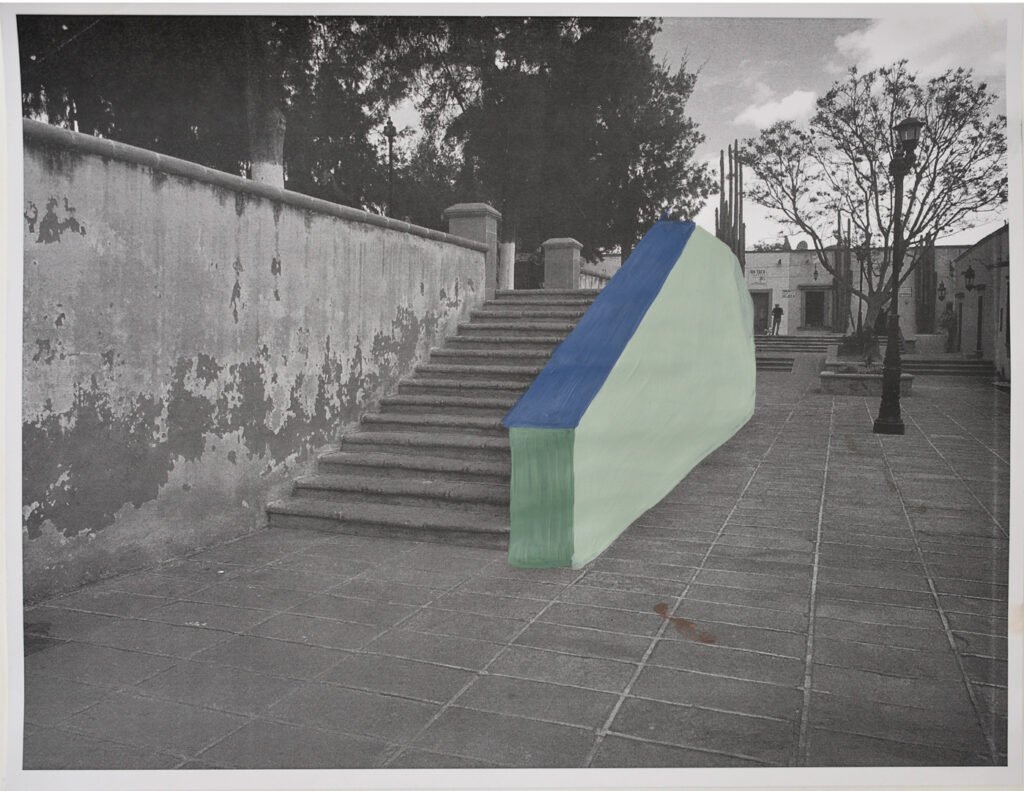
G: Además de ese curso, ¿hiciste otros?
C: Hice la maestría en San Carlos y también hice otro programa que se llama Diplomado de Producción Artística, que lo dan en la Casa de San Agustín, Oaxaca. Entonces con esto de estar tallereando con diferentes personas tus proyectos o tus ideas… Me han ayudado bastante como a, pues sí, a tener un feedback. Siento que tuve una etapa muy ermitaña de sentarme a pintar y pintar. Como que estaba muy clavada con lo que estaba pintando, pero sí me sirvió mucho como platicar el proyecto. Luego de ahí han salido cosas muy chidas, que no necesariamente terminan en una exposición, pero pues con amigos con los que puedes discutir. No sé si respondí la pregunta.
C: So, I started to think about my exhibitions, more like agreeing with your friends to show your work, I don’t know, it was… I mean, you put together little steps and eventually you realize you got experience, over 10 years, and so you can tell you: “ah, I think it is”. I said it because I finished my degree in 2011.
G: Long ago…
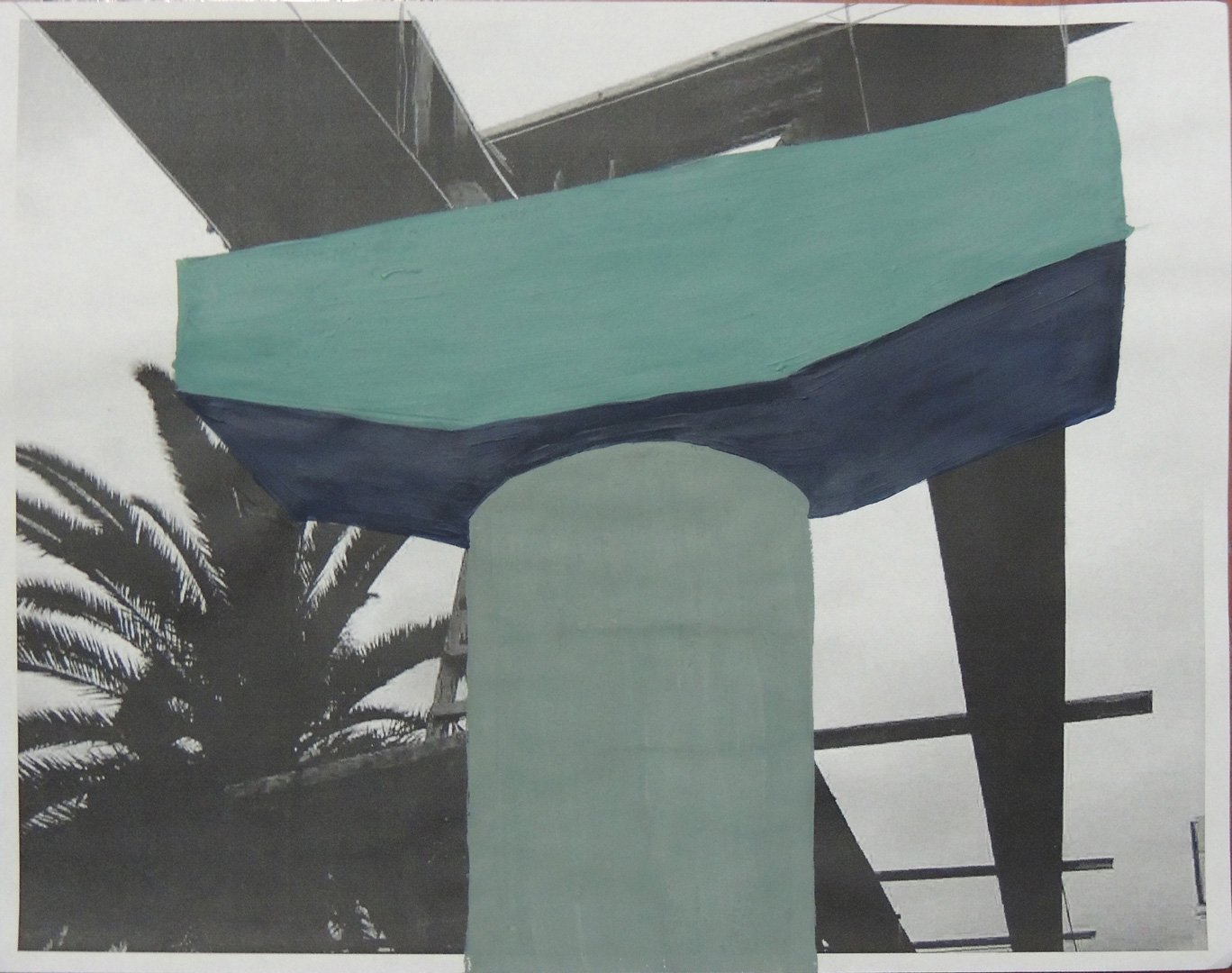
G: Me gustaría profundizar en eso porque creo que es una condición, bueno, por un lado, el hecho de que hayas hecho muchas cosas paralelo a tu trabajo como artista y luego, el otro, como andar deambulando en la colectividad para poder producir ideas. Siento que es una cuestión muy necesaria porque creo que hay mucha banda que solamente se centra en hacer lo suyo y está muy clavada en eso. Entonces, más bien mi pregunta sería si crees que esa colectividad y el hecho de que te vayas llenando de muchas otras cosas que no tienen que ver con arte, el hecho de trabajar en heladería o ser maestra, si eso te ha ayudado a ti a consolidarte
C: Sí, sí, justamente creo que lo que siento que me pasa es que tengo que invertir tiempo y esfuerzo en trabajar de «otra cosa» para tener recursos, para poder intentar hacer obra en la tarde… De mi trabajo actual salgo a las dos de la tarde, como, e intento mentalizarme para que por lo menos cuatro horas que me quedan en la tarde pueda venir aquí a pegar cartón y pintarlo de un color que me guste mucho. No sé. Siento que toda esa energía de la mañana me permite que logre estar estas cuatro horas acá pensando y tratando de hacer obra. También es como bien complicado a veces quitarse ese chip laboral, pero bueno, se tiene que intentar. Voy a cumplir dos años en este estudio que estoy rentando. Nunca había tenido estudio antes, siempre había trabajado en la sala de mi casa o en mi cuarto, pero cuando fue pandemia, los espacios comunes de la casa se volvieron a habitar, y entonces ya no podía andar ahí a media sala con mi barbotina y mi barro de cerámica empolvando todo. Luego estas figuras de cartón también empezaron a crecer mucho. Y ya estaban por todos lados habitando la casa. Fue entonces que sentí la necesidad de tener un espacio de taller, y pues seguir chambeando para poder financiarlo.
G: Hablando específicamente de las esculturas, esas que estás haciendo ahora recién, de dónde surgen o cómo surgen, ¿cuál es la historia a través de?
C: Sí, pues empezó con esta serie de papel. Pensaba en que en los momentos en los que me daba tiempo de «pensar en arte» eran los tiempos de trayecto de mi casa al trabajo o del trabajo a la escuela. En ese trayecto tomaba fotografías. Esta serie son fotocopias de fotografías que tomo con el cel, las imprimo en blanco y negro, me pongo a pintar sobre ellas, con acrílico, los objetos que me parecen sumamente escultóricos. Así empecé a generar este archivo. Son cosas cotidianas que te encuentras caminando. Entonces tienen que ver con momentos de trayecto o de traslado.
G: ¿Cómo tomar fotos random de objetos?
C: Algunas fotos las he tomado caminando y otras en el transporte. Si. O ubico dónde están y luego cuando tengo más tiempo vuelvo y le tomo una buena fotografía. Otras son así como más de paseo. Por ejemplo, aquí fui a ver a mi amiga a Querétaro y me llevó a este lugar bien raro que tiene cómo estas estructuras que no entiendo para qué son, pero existen. Entonces esa forma me atraía aunque también era muy estorbosa. Este archivo que llevo haciendo desde el 2018, cada que puedo, tomo fotos y las intervengo. Y ahorita, por ejemplo, tengo pendiente este mes como unas 30 más para pintar. Siento que es algo que no quiero dejar de hacer porque me ayuda a ubicar estas formas de la ciudad que me parecen casi esculturas, pero que también tienen como un fin de bloquear al transeúnte. Me interesa que en esta segunda serie, de pronto se pierde su función y se vuelven sólo formas abstractas. Como que ya solo son formas geométricas que alguna vez vi en la ciudad. Esos los hago en papel. Y me gusta que sean así, un bonche de hojas que puedes ojear. Me gusta que no sean pinturas al lienzo, que sean algo que puedes pasar de mano en mano. No sé. Y como que también me gusta mucho la fragilidad del papel, con sus arrugas y su ligereza. Y bueno, esto de hecho es una de mis mega favoritas.
C: Wah. It was. Haha. But, I also worked in alternative jobs to hold my art. I was working in an ice-cream parlor, I was a teacher for five years, and after that I was an art assistant. What more? I thought I’d be a teacher for many years, and most of the courses were not about visual art. I also worked for a while in an animation school named SAE. I learnt so many things there and eventually I was a teacher even in Unitec. I dunno. So, you had to make your portfolio and at that time you realize you got something else, you could see you got many pages and you say: “ah, right”. I think it helped me a lot, like not being defeated. I think it helped me because I have always looked for workshops and courses, so I’ve been, for example, in Centro de la Imagen. They got a certification program named SPF that helped me so much.
G: What’s that?
C: It is a certification program named SPF and it’s about photography production, and I learnt from an excellent teacher, Veronica Gerber Bicecci! I felt she made me think differently, like 180, because it was about thinking in images. So, it opened my mind to a field of imagination forms that are not about techniques or painting, rather than images. For me that term was amazing and I showed a video-animation.
G: So, apart from that, you got other courses?
C: I studied my masters in San Carlos and I took another certification program named Artistic Production Program in Casa de San Agustin, Oaxaca. So, I was on it thinking outside with other people who support my ideas. They helped me so much because you can get feedback, right? I felt I was like a recluse for a long while. I wasted my time just painting. I felt I was on it for so many days and a fact that helped me a lot was talking with others about my project. Most of the good things that I did came from it. And not all of it would become an exhibition or something like that, but just hanging over… I mean, it is cool. I dunno if I answered your question.
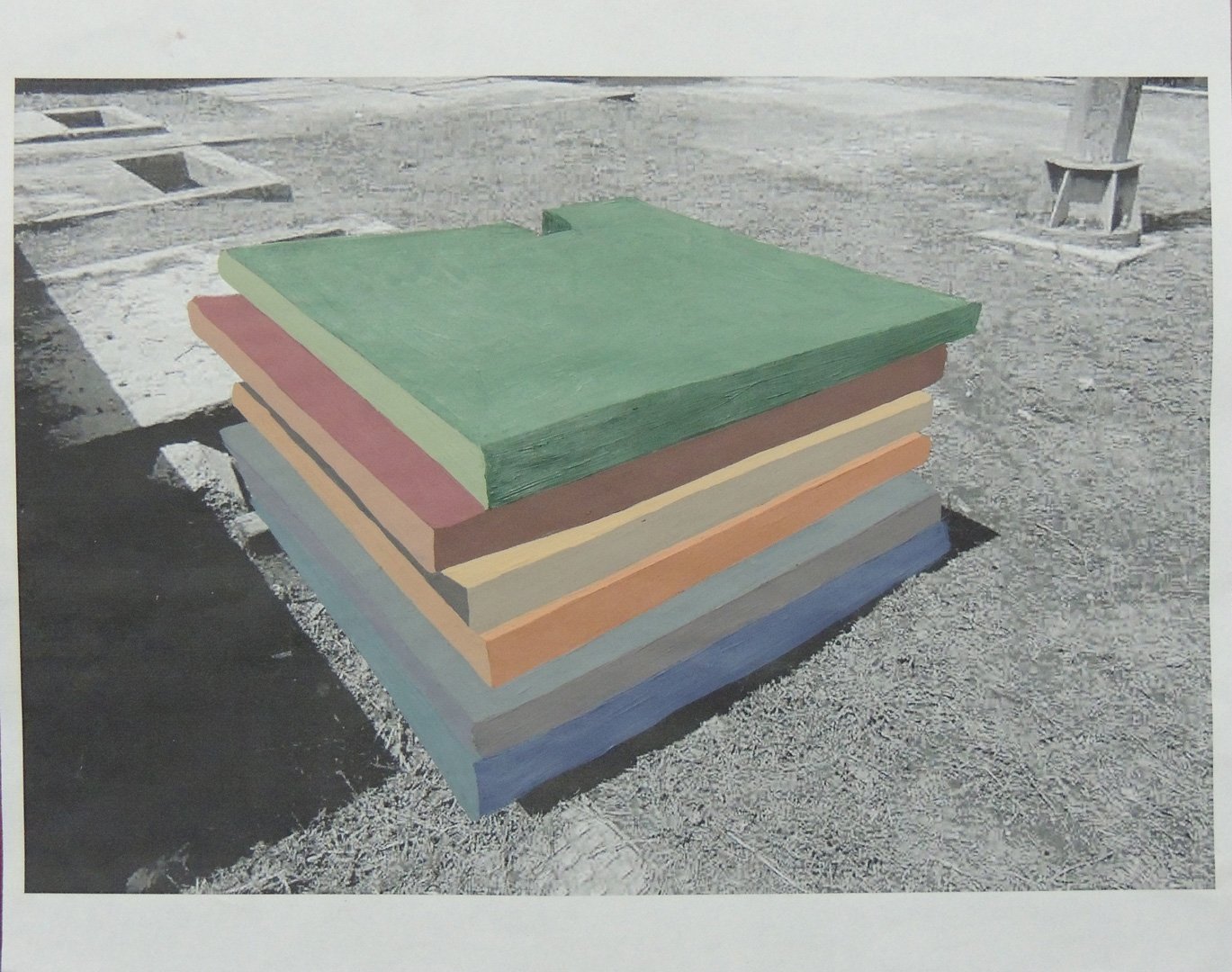
G: ¿Por qué? ¿Por qué es tu favorita?
C: Porque esta figura trapezoidal la he visto un montón de veces abandonada ahí a mitad de la calle. Lo que me interesa de estas piezas escultóricas de cartón es que las pueda cargar, que sean frágiles, coloridas y movibles. Están hechas a mi tamaño, pues, al tamaño de mis brazos. Estas esculturas buscan tener características opuestas a sus originales, que son pesados, grises e inamovibles.
G: Justamente me preguntaba cuánto pesaban esas cosas.
C: Algunas sí pesan, porque tienen una estructura interna, algunas de estas las pongo otra vez en la calle como esculturas para los transeúntes que pasamos por ahí. Pero bueno, en realidad todas vienen como de unas maquetas pequeñas. Tengo varias. Cómo que resultan ya un poco abstractas.
G: Me resultan demasiado locas. Y creo que por eso me resultan también bastante poéticas.
C: Si, lo son. Por ejemplo, esta es una de mis favoritas porque ya no me acuerdo qué era. Creo que era como una cabina de teléfono. De hecho, el libro que sacamos junto con Piedra Ediciones, es para que puedas armar tus propias esculturas. Como que tiene esta onda de…
G: Si es más lúdico, ¿no? Como cuando ibas a la papelería y lo comprabas y tenías que hacer como… Te pedían en la escuela tu… No sé qué, pero tenías que armarlo.
C: Exacto. Y además estos justo tienen esa característica desprendible/armable… Lo arrancas, lo armas, lo pegas con cinta doble cara, y ya tienes las esculturas; si lo decides armar, es un libro de esculturas, y si no lo armas es un libro de pintura. Justo me gustaba esa idea de hacer la escultura «compartida». Porque… Estas formas que de alguna manera vienen de las formas que noté en la calle, lo que les pasa es que vuelven a estar en la calle. Pensaba que estos son módulos de colores que… O sea, que son módulos de pintura. Cada uno cumple como una función en una pintura para el espacio público. Me gusta la sensación de que compartimos cosas como de mano en mano, pues como que estas pequeñas maquetas tuvieran esta edición reproducible. Ya no me acuerdo qué preguntaste, pero sí.
G: I would like studying in more detail about that condition, well, because, on one hand, I think that fact is so deep. I mean, you’ve got alternative jobs and then you use your time for art production, to think and picture. I feel many people think that art is just about being cool, with so many commissions and projects related to them. So, I’d like to study in more detail about that kind of community and that thing related to work as a teacher, for example.
C: I think I might use my time and my effort working on something else, so I can earn money, and then I would get time to try… Making art… I leave my job at 2 o’clock and I even try to think that in the next four hours I could use it to go to my studio and paint cardboard boxes. I do not know. I feel this morning energy allows me to make art eventually. It’s complex, you know? You also try to take out your professional chip and then you try to think as an artist. Two years ago I rented this studio and it was so rare. I have never been working in a studio, I used to work in my living room or in my bedroom, but, during the pandemic the common spaces in the floor became public again. So, I couldn’t dwell in these common spaces to make sculptures with mud, you know? And even then sculptures became bigger. And it could not dwell in the house with us. So, I feel I needed a bigger space like a studio and I had to work more to pay for it.
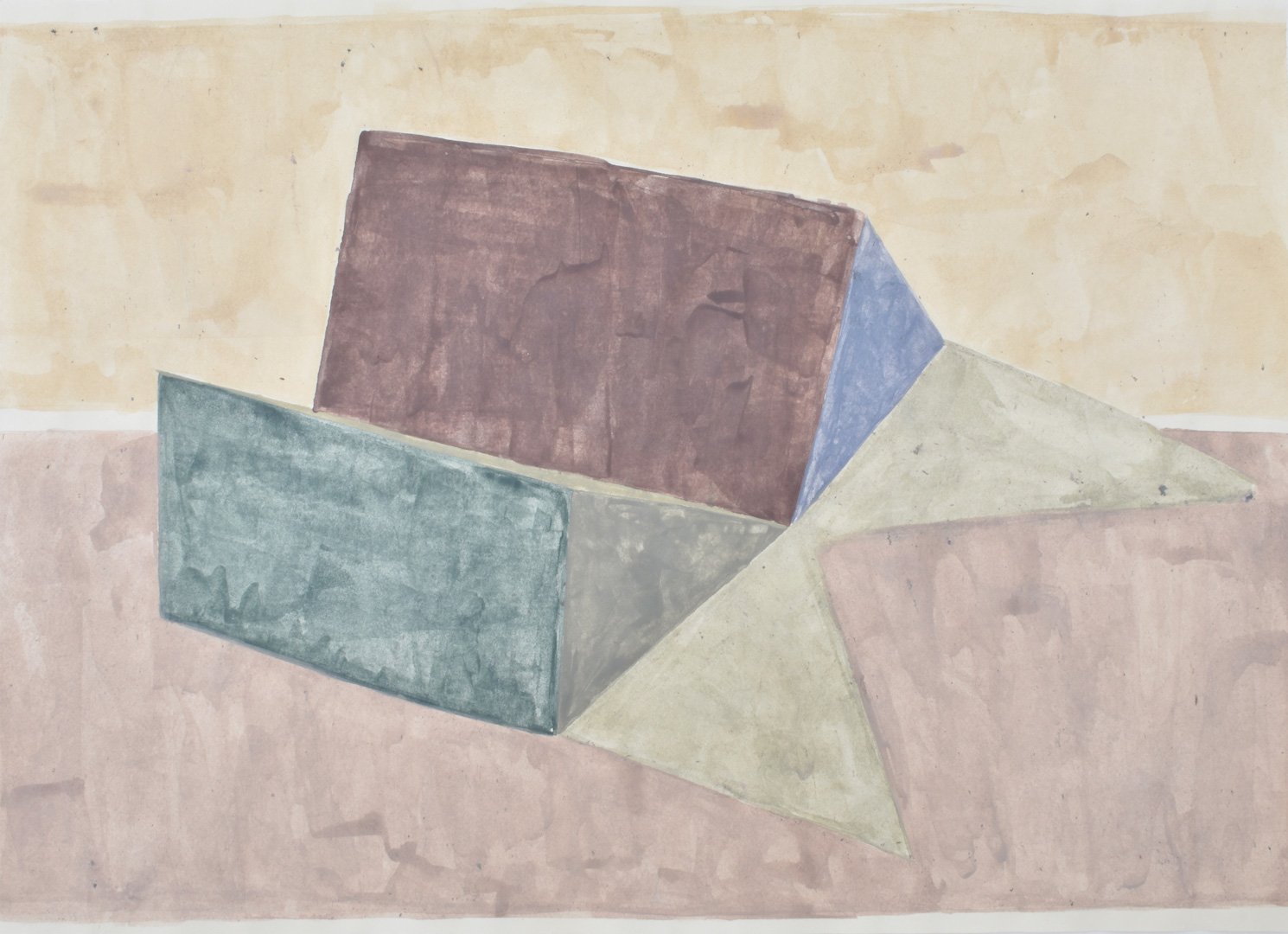
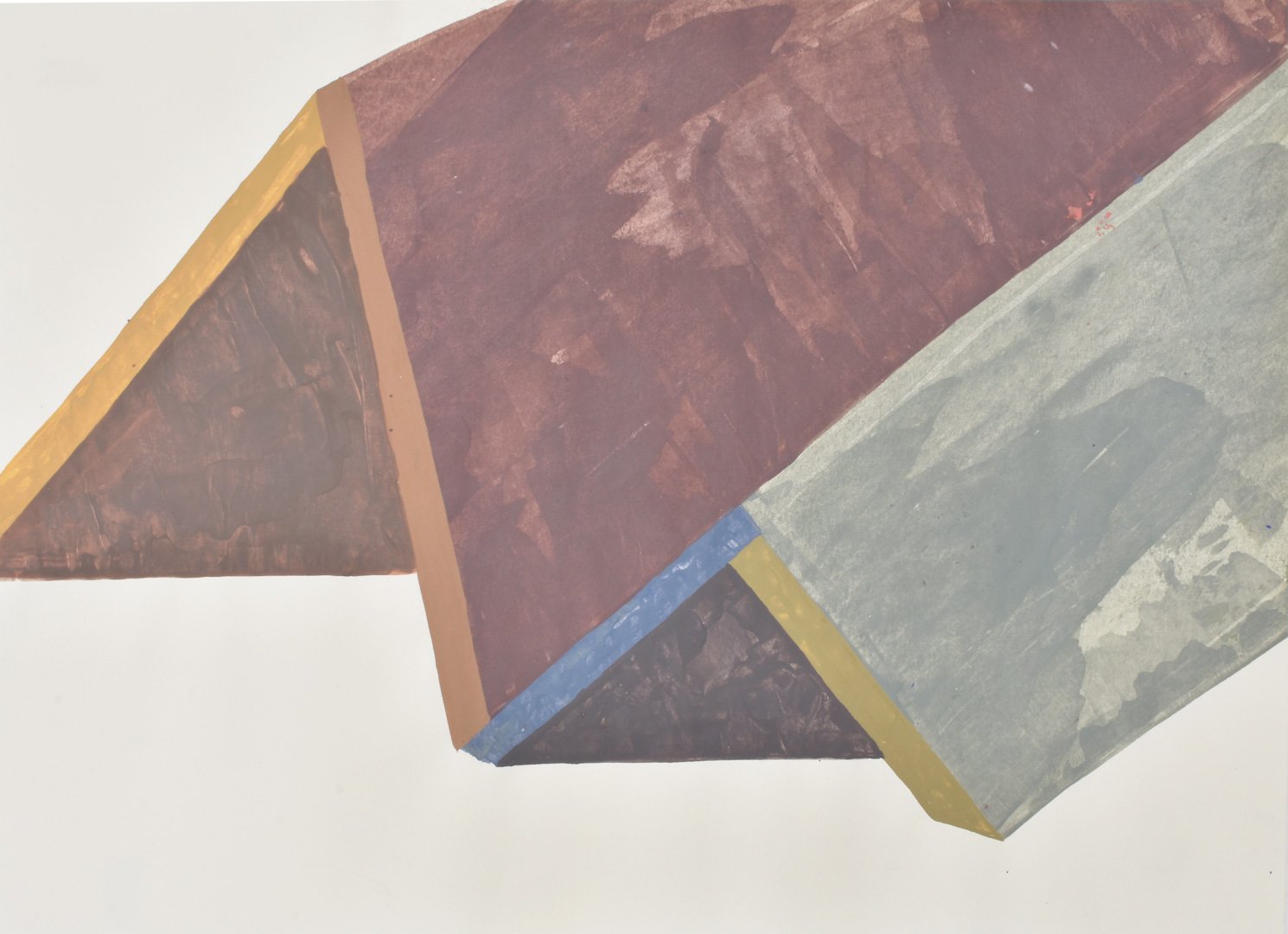
G: Te preguntaba sobre la historia de las esculturas, de las pinturas. Pero, antes de seguir quiero decir que me parece muy chido todo este trip, primero, el acento que le das a las formas que vas encontrando en la calle. Eso me parece muy chido. Porque… No sé, son objetos tan cotidianos que creo que pronto al no acentuarlos, al no enfocarlos, como que los perdemos completamente de vista. Y acá es completamente lo contrario. O sea, eso me parece muy lindo. Encuentro cierta belleza poética en traducir de pronto esas formas, a descontextualizar sus propiedades. Me parece muy, muy interesante. Y también me parece muy interesante porque de pronto esas formas que agarraste de algún lado, de pronto como que ya no te acuerdas que son, ¿sabes? Como que van cambiando de función y simplemente son objetos que tienen otra razón de ser. Esa naturaleza del objeto ya terminado me parece también muy bella porque es como que le quitas la carga, ¿sabes? Todo el peso de la cotidianidad y la carga ingenieril que pudiera llevar. Solo lo dejas a su forma más pura y eso es muy interesante.
C: Sí, y eso también me causaba mucho conflicto porque al principio yo pensé que esas formas sólo me gustaban por su forma escultórica. Pero, luego en un taller que tomé. Se llama Círculo de Crítica de Obra, lo da Fabiola Menchelli. Lo tomé el año pasado. Me ayudó a llegar a cosas que ya intuía y no sabía cómo enunciar, me ayudó un buen, porque como que estas formas de concreto existen en la realidad emplazadas en las banquetas, objetos de contención del urbanismo. Y a mí me atraen. O estos objetos detonan para mí un montón de cosas, escultura, pintura, todo. Pero, también hay otra parte en la que me preguntaba por las cuestiones políticas que implican su emplazamiento en la vía pública quién decide qué poner en la calle, además de que es súper invasivo, está a mitad de todo y que implica muchas cosas, determinan cómo caminar la ciudad, que ya de por sí es bien complicada. Más siendo mujer. Terminan siendo objetos de obstrucción que priorizan la velocidad de los carros por sobre peatones, y otras terminan siendo una reliquia de concreto en la ciudad. A veces les veía una ligera similitud con la escultura minimal, pero en el contexto de esta ciudad: ¿para qué se hizo? ¿Y por qué mi cuerpo tiene que adaptarse a ellas? Mientras dificultan mi paso, mi descanso o la reunión. Hay unas que sí tienen funciones como muy-muy claras…
G: Lo que creo que es bien romántico de todo esto es que puedes mirar piezas y formas en cualquier otro objeto, como si le sacaras una radiografía. Y te educas al verlo, ¿sabes? Vas por la calle e inmediatamente volteas a ver estas cosas porque tu ojo ya las reconoce.
C: Me obsesiona una en particular. Está emplazada en una plaza comercial en el Pedregal. Es una cosa que es como para delimitar el paso de los autos, y me puse a hacer un símil de ella, no me interesaba que fuera exacta, usé las medidas de mi cuerpo para «recordar» su altura, su anchura, etcétera… Luego, en una visita posterior, vi que tuvieron que ponerle cinta vinílica de seguridad a las originales (con rayas diagonales amarrillo con negro). Es muy increíble esta forma-trapezoide porque… Trataron de camuflarla con el suelo, que es creo que mármol. Y al tratarse de una plaza comercial «exclusiva», pues la poca gente que entra caminando y no en carro se tropezaba. Se me hizo una situación muy absurda, su existencia. Reproducir esta forma en cartón. Intentando desarrollar situaciones opuestas con su símil colorido, ligero, transportable e incluso removible. Y que si te estorba, lo puedas quitar, te lo puedas llevar o lo que tú decidas, ¿no?
G: Está muy loco.
C: Pues, al final me obsesioné un poco con eso. Y además hice varias acciones con este objeto símil de cartón: lo llevé conmigo por un mes, lo llevaba conmigo si salía. Pensaba en que si de por si se me hacía bien absurda su existencia en la vida real, entonces iba a hacer acciones aún más absurdas con su símil: sacarlo a pasear, llevarla a los columpios, de paseo por el parque, etcétera… Y la última acción que viví con ella fue hacerla flotar por un río hasta que se destruyera. Era un poco… Cómo pensar en ese reclamo que yo tenía ante este objeto y su existencia en la vida real. Simbólicamente estaba reclamando mi inconformidad como transeúnte. Preguntarme cómo porque existe eso: ¿por qué está ahí? Lo que pasaba es que al final sentía que todo tenía que ver con una sensación de que no están hechos ni pensados para nosotrxs, sino para los vehículos, por ejemplo, para priorizarlos a ellos por encima de peatones, pensaba en todo eso, como en el tiempo invertido en transporte, en preferir caminar, en la inseguridad y además tener que sortear todos estos obstáculos a mi paso.
G: Talking about sculptures you made, I wanna ask you about how you created them. What is their story behind?
C: Well, it begins with this series on paper. I thought that the moments when you could think in art are normally in the trip from home to work, right? So on that trip I took photos. And then I printed them on paper like photocopies and I just painted on them with acrylic, only on the elements I considered sculptural. So, I started to generate this archive about daily things that you could see while walking. And it even has its own energy related to that trip.
G: Like photographs of random objects?
C: Some of the photos I took were while walking or on the subway. Yeah. I think I place the forms and then when I get some time I take a photo. Others came from travels, I guess. For example, one of them was taken when I visited my friend in Queretaro, so she invited me to that rare place that has these kinds of structures. I have no idea why it is placed on it or what is its function, but it’s interesting to me because that form was so kind of a bother. I have made this archive since 2018, and I have been trying to do my best as well as I can. For example, I must solve 30 pending drawings I gotta paint. I feel it’s something that I will never give up because it helps me to place those things in the city and question its own form. I am interested in it because things lose their own function and then they become abstract forms. I mean, it reduces its meaning into a geometric form that I used to see in the city. And I prefer to draw them on paper. It is just like sheets that you can glance through. I love that kind of drawings more than oil paintings because the sheets can be passed by hand. I dunno. And I even like the delicacy of them, their wrinkles and fragility. And, well, I am on it. I love this piece, for example.
G: Why? I mean, is it your favorite piece?
C: Because I saw that figure many times just abandoned in the middle of the street. It amazes me that these pieces are sculptural forms from cardboards boxes. And that’s the meaning: sculptures that I would carry and also fragile and colorful. They’re made for my height and my arms, I dunno. With these sculptures I tried to remark their meanings that are opposed to the originals. The originals are gray and weight.
G: Yes. I just questioned myself about it.
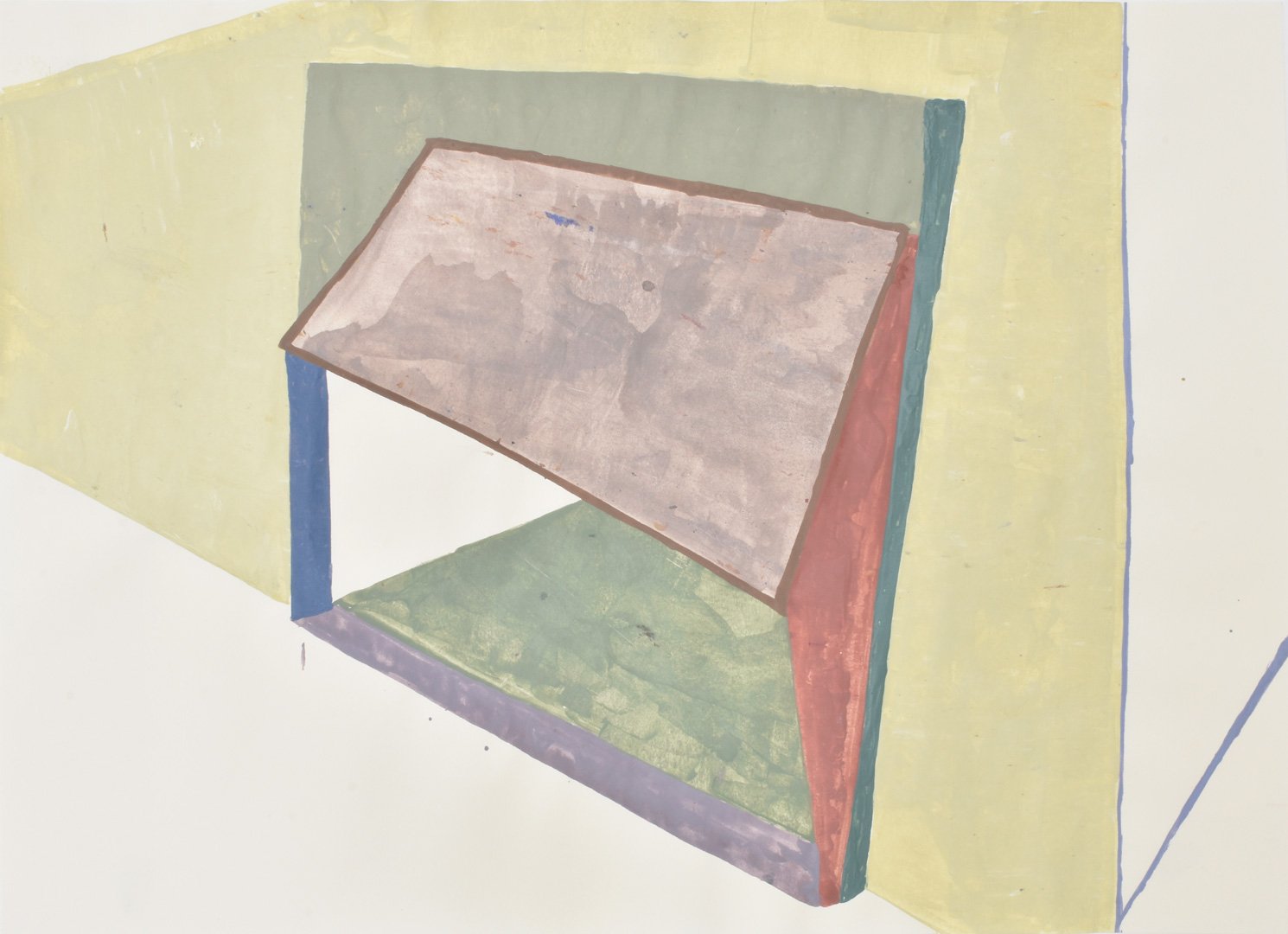
G: Claro, porque son formas que parten de un sujeto particular y son más bien como monumentos a esa condición, ¿no?
C: De hecho, otra serie que estoy trabajando, que tiene que ver con todos estos otros obstáculos invertidos, que en realidad son obstáculos cóncavos en la banqueta (hoyos), que tienes que estar sorteando a cada rato. Se ha vuelto «normal» caminar y tener que esquivar estas cosas y situaciones, ¿no?
G: Sí, sí.
C: Entonces, es una serie pictórica en la que voy registrando todos esos hoyos en las banquetas que he tenido que esquivar… Y es del tipo de pintura que empezó más o menos por la época en la que pinté esa portada de Erik que me mostraste de su libro Los Procesos, allá por el 2012. Hay como estas perforaciones con las que nos encontramos todos los días, son como composiciones de objetos así super random.
G: ¿Estas las pintas sobre cartón?
C: Sí, esto es sobre cartón. Ah, eso es lo que te contaba un poco, ¿no? Me gustaba dejar como no terminada esa serie de pintura porque siempre parecen en proceso de «terminar», pero es incierto. Además de que me gusta mucho el cartón como superficie industrial, sencilla, con capas y frágil en apariencia.
C: Some of them have intern structures, so they weigh so much. I put some of them back on the streets just for people who are walking nearby. But, ah, I think it really comes from little miniatures. I got some. So like abstract, I guess.
G: I think they’re so crazy. And I believe because of that I consider it to be poetic.
C: Yes, they’re. So, for example, this is one of my favorites, I didn’t know why. Maybe a phone box. Instead, the book we published with Piedra Ediciones… It’s about what you can assemble on your own. So…
G: Like something that is ludic, right? Just like when you go to the stationary shop and buy some paper and you try to make… Like cardboard figures.
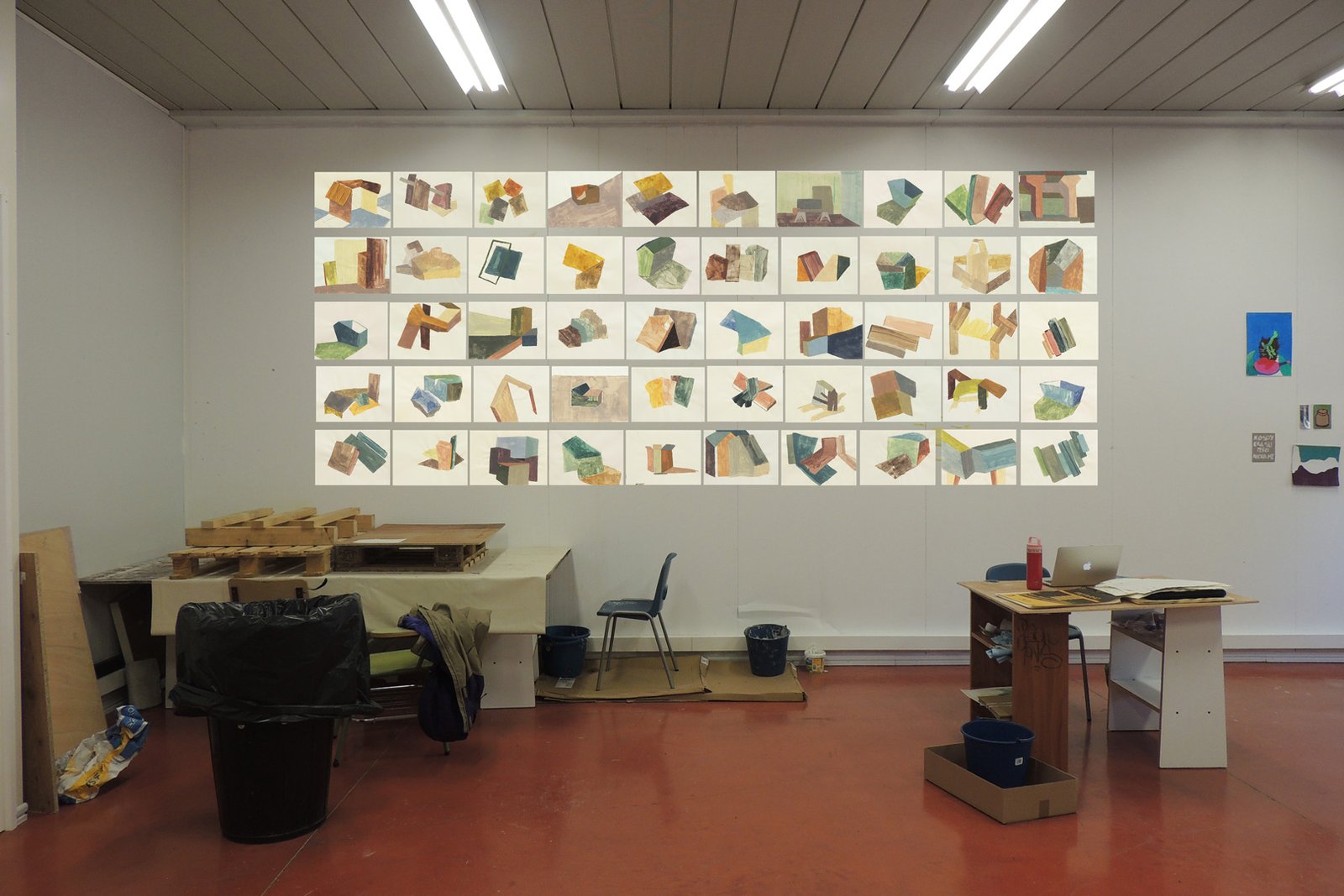
G: O sea, que no tienes algo que…
C: …He tenido que ir aprendiendo del material; en su momento en realidad yo empecé a usarlos por economía. El cartón reutilizado. Todavía lo hago. Pero he ido encontrando otras características bondadosas y ordinarias de este material que dialoga un poco con desacralizar el papel de la pintura, con ‘P’ mayúscula. Y pues de trabajar con objetos reciclados u ordinarios, por ejemplo, si una amiga se acaba de comprar un refri pues le pido su caja y trabajo con ella.
G: Creo que hay una traducción bastante útil allí, ¿sabes? Porque creo que el universo es mucho más amplio entonces, es decir, la forma o el objeto puede tender a otra cosa también, ¿no? O a agruparse. O sea, puede ser otra cosa, y esa amplitud de significados me resulta interesante.
C: A mi lo que me pasó es que empecé a conformar un glosario de formas miniatura. Me gustan mucho las miniaturas, poder sostener entre mis manos una escultura que de por sí ya hice con mis manos, se me hace como bien padre; pero después no me hizo tanto sentido que fueran tan pequeños porque mi encuentro con ellos en la calle fue a través de mi corporalidad, con mi escala, mi cuerpo es quién se confronta con ese objeto, entonces fue que sentí la necesidad de hacerlas del tamaño que yo recordaba que me había afectado corporalmente. Incluso a veces siento como que estas esculturas de cartón tienen otra característica, que tienen que ver con su aparente fragilidad, y pareciera que requieren de mi cuidado. Una dualidad amor/odio de una geometría que no es inocente.
G: Por ejemplo, en la selección del color que ocupas, ¿eso es muy random o tienes alguna paleta de color específica para todas tus piezas?
C: Pues, como que creo que las pinto como a mi me gustaría verlas en realidad. Como que estos bloques originales de concreto tienen asignados colores estatales. O sea, ese «verde patria», el amarillo vehicular color piolín, o el turquesa de las oficinas donde vas a pagar el agua… Son colores que de inmediato relacionas con instituciones. Pero, justo, las pinto de los colores que a mi me hubiera gustado que tuvieran. Toda la paleta cromática que uso siempre tiene un trasfondo color gris que denominó gris ciudad. Es un gris que está muy tocado por el polvo, por el paso de los años, por la intemperie y la contaminación de la ciudad. Aunque en mis esculturas, los colores son aparentemente apastelados, trabajo para que tenga una pátina de este gris ciudad. Al final son colores opacados, no brillantes, sino atenuados por el gris ciudad.
C: Exactly. And even though it has that characteristic like detachable… You could strip it off, assemble it, join it, attach it with masking tape or something and then you got the sculpture, and if you decide you don’t wanna do it you just have a book about paintings. That’s the fact! And for me it’s amazing you can choose how you play with the book. And perhaps I love the way of creating collaborative sculpture, you know? Because… These forms I saw in the streets, I mean, they went back to the streets in such a way. I think about its color because it is just a paint module. Each one has its one function in the landscape and I like the feeling we share about them like handcrafted meanings that you can pass by hand, and the book is just like you can get miniatures. I dunno. I remember no what you asked me.
G: I asked you about the story behind sculptures. But, first of all, I want to say that the trip seems so cool to me, firstly because the forms are forms that you see in the city, and then because they seem to me like ordinary things that people just ignore due to they’re so common, right? I mean, you remark on them and that process seems to me so pretty! So poetic! I am interested in the properties of these forms that I consider are so decontextualized, you know? I think you just take an object from the street, you treat it and simply you get an object with another personality. Without the common sense and the engineering aspect that it would get. Just the essence of the form. It’s interesting.
C: And it also makes me feel confused, you know? Because at the beginning I thought that forms seemed interesting to me just by their forms. But, then with the workshop (named Círculo de Crítica de Obra, by Fabiola Menchelli) I realized that forms are made of concrete and their function is so deep: hold back pedestrians. She helped me so much. And I feel attracted by the forms because they make me feel so much and detonate so much inside me. However, I also think politically about them because those forms implicate their place in the public way, you know? And also think: who decides about it? Because forms are invading streets and even if the city is now such a complex to walk, most like women, the objects there will become in concrete vestige than none use. Sometimes I guess my sculpture is more like minimal art, but then I think the city is so complex and the form is not minimal, it has a very deep research behind it. I mean why does my body have to adapt to it?
G: I think it can be lovely because you can watch the pieces and you can get a radiography of them by painting. And you’re learning so much just seeing it, you know? You just walk on the street and your eyes just know that far away you can recognize a form.
C: I’m particularly obsessed with it. For example, one day in Pedregal, in a citymarket, I saw a form. A form which was made to split the way to pedestrians and cars. And it seems so interesting to me. Not by the form itself rather than the function. And I tried to make a similar one. I remembered the height and the width and just did it. Months later I went back to that place and I saw someone put yellow tape on it. And it seems very rare to me because the pieces were designed to camouflage itself with the ground, which is marble, but people while walking just stumble. It is absurd, right? I tried to replicate it in an opposite way which can be transportable, light, colorful and even detachable.
G: That sounds crazy!
C: In the end, I say, I was obsessed with it. And even though I made so many sculptures, I went out with some of them. I thought that they were absurd and so I would remark that absurd on the trip with them. I walked with it, I went to the park, and even the last one went with me to a river and I just made it float until destroyed. It’s more like… Like thinking about my scheme or a way of symbolically questioning their existence. And maybe I decoyed my nonconformity as a pedestrian. Just ask: why is it there? In the end I felt they’re made not for pedestrians rather than cars, for example, cars are more important than people, and I tried to think around it.
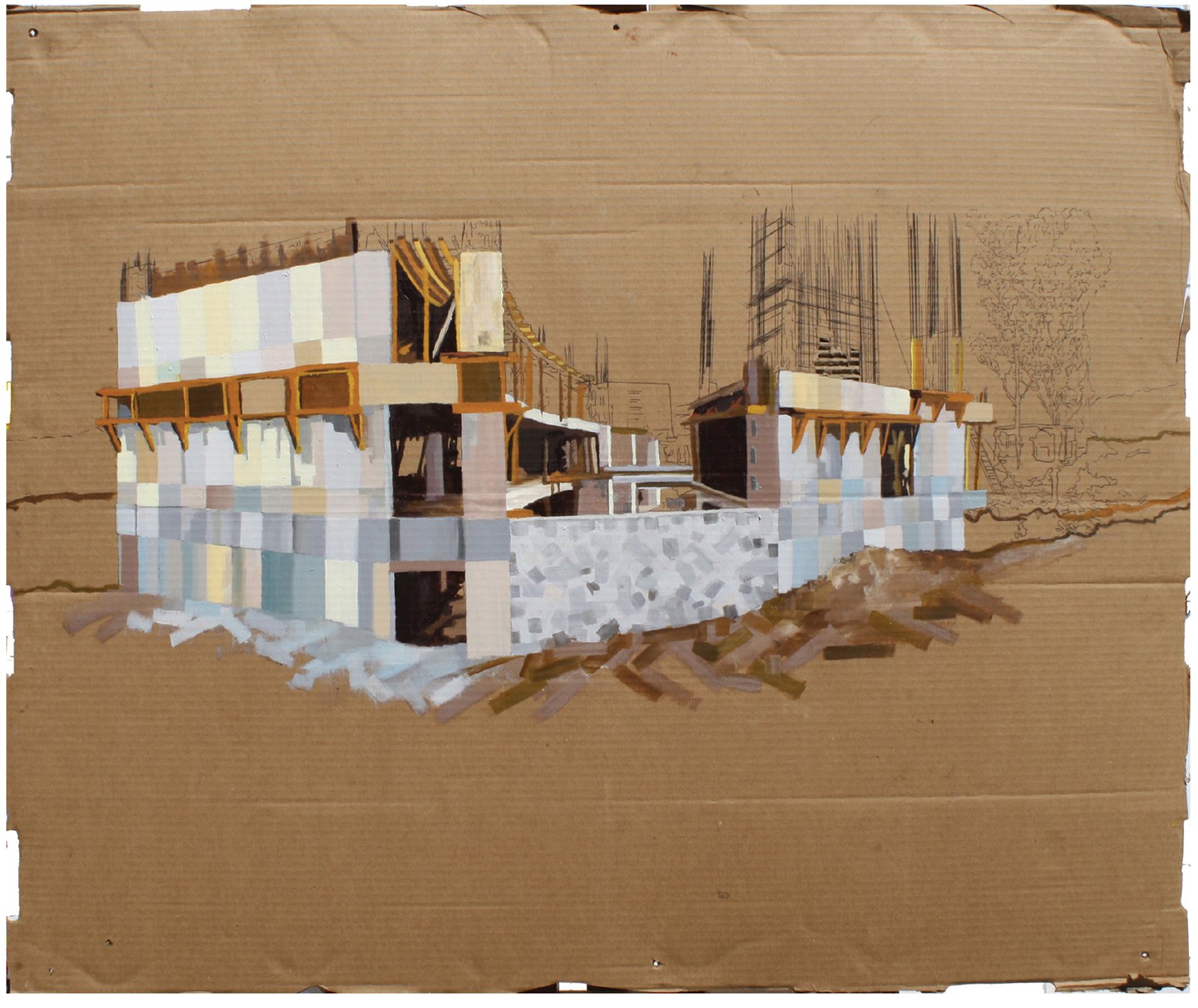
G: Of course, I think that forms are based on the car and they’d become vestiges that honor that condition, right?
C: Indeed, I’ve been working on another series that is about reversed obstacles like holes that you would face in the street. I feel it is common to walk and avoid things, right?
G: Yes, I guess.
C: So, it is more like a pictoric series that I archive. That kind of painting started in the time I painted the book cover I did for Erik, just one you show me in his book Los Procesos, in 2012. In that painting you can recognize the hollows that everyone has to avoid in its walking. It’s just about random things, I guess.
G: All of them are painted on paper?
C: Yes, of course. On cardboard boxes. As I said to you before, I paint on cardboard by economy. I still do it. But, I love the aspect of the paintings that is non-complete or untrue. Even though I love cardboard, it is industrial and fragile.
G: I think you got…
C: …I have learnt from materiality; although I used to use it for economics. However, I found out other properties on it that are so pretty like demystifying academic painting by using paper. And remarking the meaning by using recycling objects, I mean, if my friend just bought a fridge I ask for the cardboard and I work with it.
G: I think there’s a kind of translation that’s so cool, you know? Because I think you created an universe with common objects. And when you group together you would put the meanings… I dunno. It’s interesting.
C: I think I started to define a kind of glossary of miniatures. Like a compendium. I like miniatures so much that I can hold them with my hands. I love that feeling because I made it with my hands too. But, years later I recognized miniatures were wrong because I saw in the street other sizes related to my corporeality. So I’ve tried to do them by the sizes I remembered. Even if they are fragiles I think it is about duality love/hate because I should take care of them.
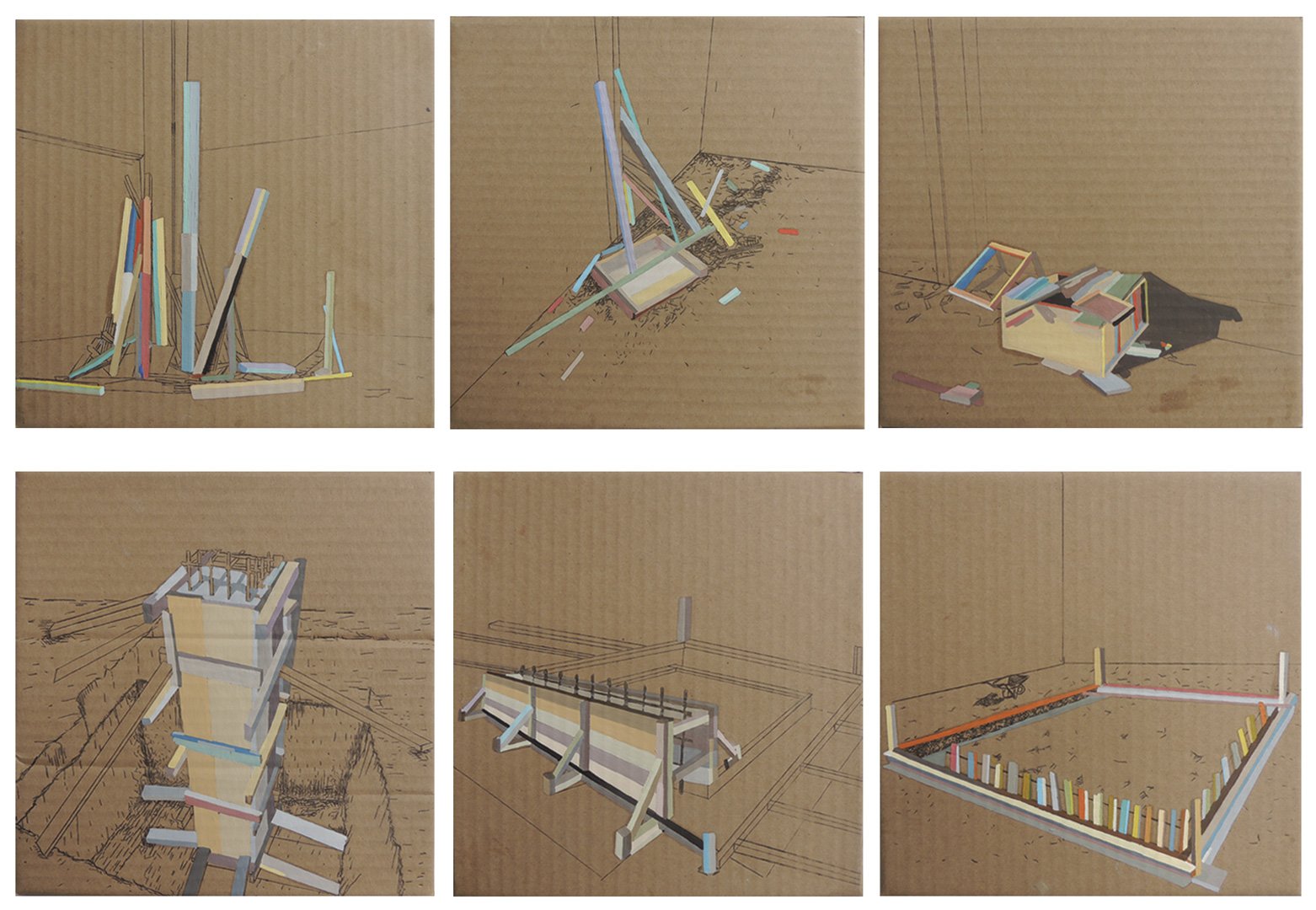
G: Ya. Justamente me preguntaba por eso, porque eran piezas que estaban en una gama cromática muy similar. Y me preguntaba si tenía algún trasfondo o una especie de significado, o si partía más bien como una cuestión meramente estética.
C: Una cosa que me interesaba, por ejemplo, es que creo que yo pasaba todos los días para ir al metro, pues de alguna manera, no sé si ya es por esta misma investigación, pero todo el tiempo encuentro o reencuentro objetos. Y pensaba como en los módulos y en los moldes que te hacen este mismo objeto. Seguro hay como mil millones en todo México, entonces como que justamente también quería que los que yo hiciera en cierto sentido fueran únicas, que ninguna escultura fuera exactamente igual al otra, que se alcanzaran a ver los dobleces y el trabajo manual que requirió construirla. Como de: «este pliegue aquí está pegado porque ya no me alcanzó el cartón y ya no me cerraba la figura y entonces tuve que ponerle un parche». Porque en realidad nunca van a salir así como de un molde, ¿no?
G: For example, choosing colors… How’s that?
C: Well, I think I paint them just like I want to see them in reality. Like those yellow blocks of concrete that seem institutional to me. I mean, they’re painted with institutional colors. And, I paint them like I want to see them in the street. But, yeah, I got a story behind it. I mean, all of the colors I use are behind what I named citi’s gray. It’s a gray that is touched by time, and dust, and the open sky and touched by pollution of the city itself. Although my sculptures are colorful they are based on that gray that is not bright or…
G: Ya’ll. I just thought about it. And I tried to find out the meaning behind it. I thought it was a random choice.
C: One thing that I’m interested in is that I think I wasted my time seeing those kinds of objects while walking. And I even dunno if it was a kind of research or something but I’ve always faced them on the streets. I thought that those forms had a pattern. I mean, surely you’d find so many around Mexico, you know? Millions of them. And based on it I wanted to do my sculptures like unique pieces. Like: “oh, there is no more cardboard so I had to put a patch”. Because they are not based on the idea of pattern, right?
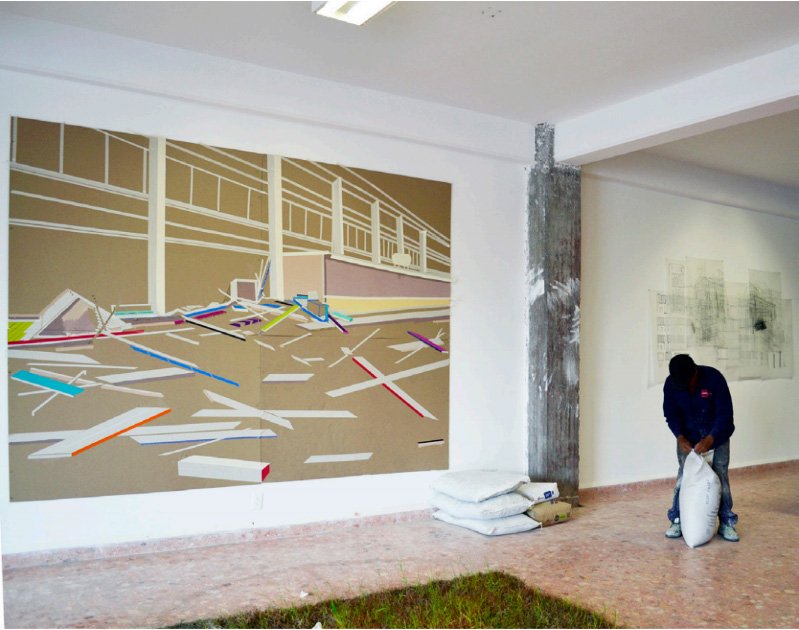
G: Algo que también veo en tu obra es como cierta fascinación por la geometría.
C: Está ingeniosa la pregunta porque creo que tiene que ver con el trayecto, con las cosas que me encontraba en mi caminar diario. Me gusta la idea de que hubiera como esculturas en la vía pública, o como un ejercicio pictórico que no alcanzas a ver en tu recorrido porque ya vas tarde y lo ves de reojo. Como que pensaba en eso, como: ¿qué pasa si sacas a pasear la escultura a la calle y la compartes? No sé. No sé porque clavarme específicamente con estos objetos que me se me aparecen, pero sí me gusta mucho el minimal y el land art.
G: Something I can see in your career is the fascination for geometry.
C: It is so curious, yeah, because I think it’s about traveling and the things that you face commonly. I like the idea of facing sculptures in the public way like a pictoric performance. I still think about it, like: what happens if you just go out with the sculpture and just share with the city? I didn’t know. I just love them as minimal and land art.
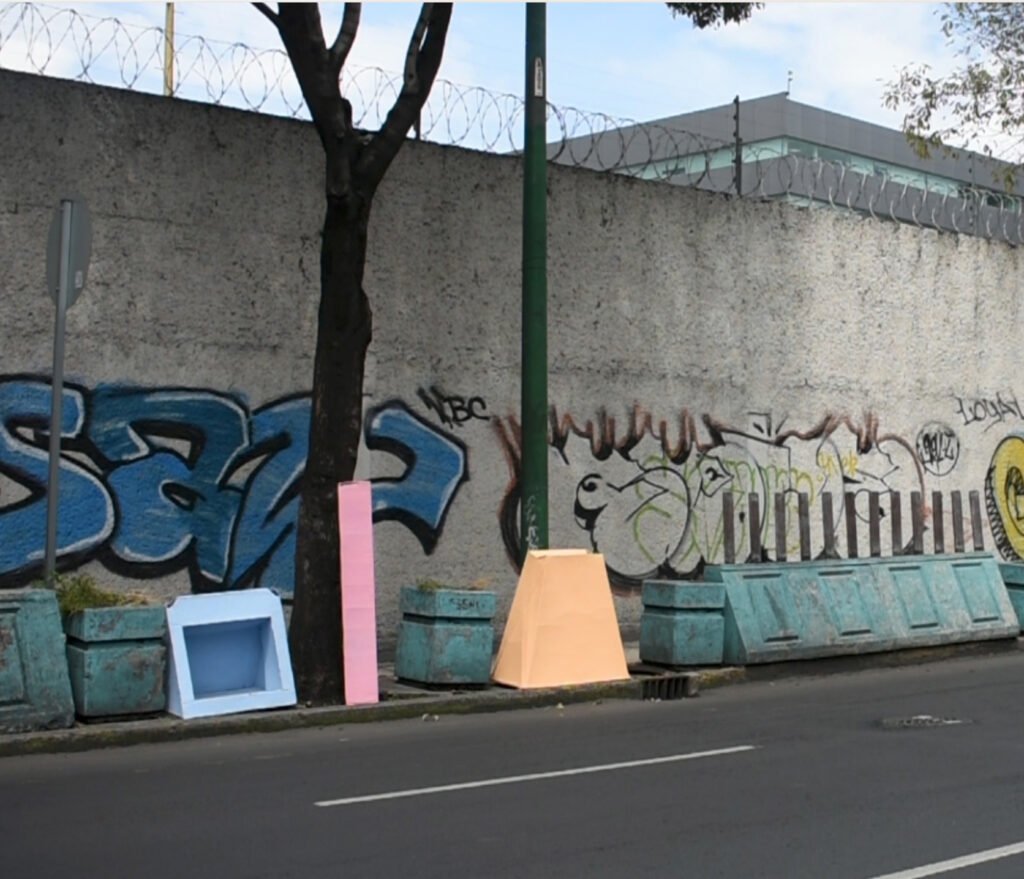
G: A mi me parece muy profundo aunque vago, sobre todo por el proceso que tienes que no es solamente el objeto por el objeto, de dibujar un objeto imaginado de pronto, hay de fondo un aspecto que involucra, no sólo con la pieza que tú produces, que dibujas primero, que luego que intervienes, que luego pintes, que luego produces en la escultura; sino creo que el diálogo con la ciudad o el diálogo que tienes con la ciudad da esa lectura paralela que la sostiene y la dinamita. También me parece muy interesante porque, es decir, no estarían los objetos sin ese diálogo con la ciudad, ¿sabes? Entonces eso también me parece realmente bello porque creo que tiene que ver con esa idea de habitar la ciudad, como un objeto que habita la ciudad de una manera anónima. Así siento las piezas: como las piezas que vas interviniendo de pronto, entes anónimos que nadie observa, pero que están ahí y que tienen mucha belleza y mucho significado detrás.
C: Eso creo que también está muy profundo. Y es que es bonito que leas esta reflexión, como el diálogo que me comentabas. Justamente eso. O sea, como que son objetos geométricos tan simples, pero yo sé que no son inocentes. Como que es algo que, o sea, como que ese trapezoide de concreto que está ahí. Y el que esté ahí implica un montón de cosas que es importante cuestionarse.
G: Las tuyas son como el hermano bueno, ¿no? De las otras piezas, el hermano frágil.
C: Si, algo así. Está muy loco.
G: Let me say it seems deep to me, even blurred. Above all because I think the process is not simply about objects being photocopied instead. I think it’s related to drawing an object, seeing it has properties as geometry but socially too, and then you paint it and make a sculpture. I mean, I think it is about a dialogue with the city about what you’ve done, about questioning some conditions that are outside. I mean, without the city these objects would not exist, right? So, it’s interesting to me just like the idea around it. I guess it also has a certain anonymity. I feel so! They have so many meanings behind them, I think.
C: I think this is also deep. And I think it’s sweet! Just that. I mean, the objects are just objects but I know they are not naive. I think it is something related to them. They implicate so many outside.
G: Yeah. Yours are like a good brother, right? The fragile brother.
C: Yes, of course. That’s crazy!

G: Pues un poco para terminar, me gustaría hacerte un par de preguntas más bien aleatorias. Cuando trabajas, por decir algo, ¿escuchas música o tienes algún ritual?
C: Como que me preocupa mucho siempre la siguiente canción que poner, por eso casi no escucho música cuando trabajo. Como que casi siempre pinto «viendo» Los Simpsons o Malcolm o Adventure Time, caricaturas casi siempre. Me encanta poner Los Simpsons, bueno, las primeras 8 temporadas, aclaro. Justo esa es una muy buena pregunta porque creo que también mucho del mundo de los colores viene de las caricaturas y mucho tiene que ver con haber trabajado como maestra en esa escuela de animación. A decir verdad, porque no sé… Como que me gusta mucho Steven Universe, Clarence, ahorita estoy viendo Bob´s Burgers. Todo ese rollo Cartoon Cartoons, que veía cuando… Mi hermana tenía como 6 y yo tenía como 12 y sí, o sea, pongo capítulos y capítulos y capítulos, y se siguen de corrido y es como mejor me acomodo para trabajar.
G: Siguiendo… Hablando de las cosas random: ¿tienes algún libro favorito? ¿Alguna película favorita?
C: Ahorita estoy clavada con este libro de acá se llama Playgrounds, es una investigación muy chida de Aldo Solano, y es sobre los parques, los parques de juego de niños. Hay objetos/juegos luego bien raros y esta investigación es igual como súper política, alrededor de que existe la noción del playground o zona de juegos infantiles y que está estandarizada, y que ya lo entendemos super bien, pero que en realidad como que viene de rescatar espacios que habían sido como ruinas de guerra. O sea, como formas que Aldo Solano investigó y se puso a fotografiar: todos estos objetos que viven muchas veces en los multifamiliares. Porque eso también es otra historia muy loca: los multifamiliares en México. También de pronto reviso cosas de arquitectura y cosas que tienen que ver con el espacio público en el que convergemos y compartimos. Hay un libro de Iria Candela que aborda la arquitectura/arte. Pues ahorita estoy como muy obsesionada con este libro de Playgrounds… Y, pues, de películas favoritas, pues no sé, creo que no tengo una ahorita que venga a mi cabeza. Ja. Ja. Ja.
G: I wanna ask you some questions about you. Do you listen to music while painting? Or a ritual?
C: I guess, hum, no. I’m always worried about what is the next song, so I prefer not listening to music while working. I always paint while watching Los Simpson or Adventure Time, cartoons indeed. I love it because I think the colors I use in my paintings are from cartoons and from my time as a teacher. I dunno really. I like Steven Universe, Clarence, and now I love Bob’s Burgers. All of the Cartoon Cartoons series that I met while… My sister was 6 y/o when we watched it, so I enjoy it while working.
G: About random facts. Do you have a fav book? Fav movie?
C: Oh. Nowadays… I’ve read a book that is named Playgrounds, and it is a very cool research by Aldo Solano, and it’s about parks and playgrounds for kids. There are rare objects in that book and even it’s also a political research, maybe around the idea of child’s playgrounds that are standardized, you know? Because most of them are based on the idea of war playgrounds. I mean, Aldo Solano photographed some of them and then put them together. And most of them are in South America. Or these buildings in Mexico which are named multifamiliar. I used to review architectural magazines or something related to public space. A book by Iria Candela, for example, it’s about art-architecture. And… Movies? I do not know. I cannot remember one. Haha.
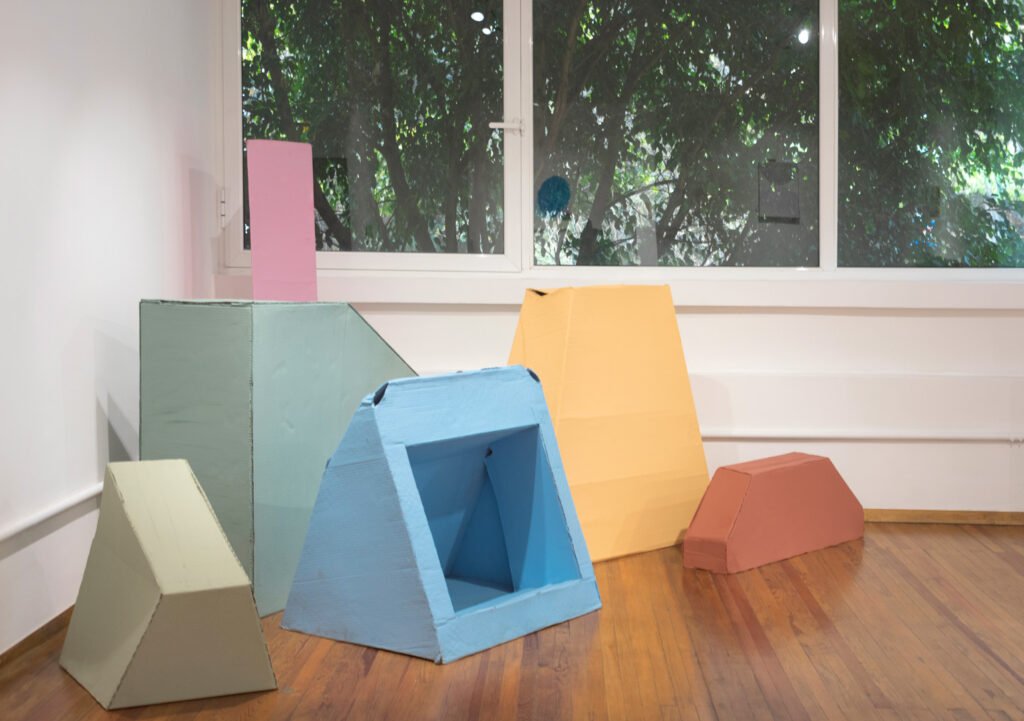
No sé para que publico, de todas formas no ves mis indirectas.